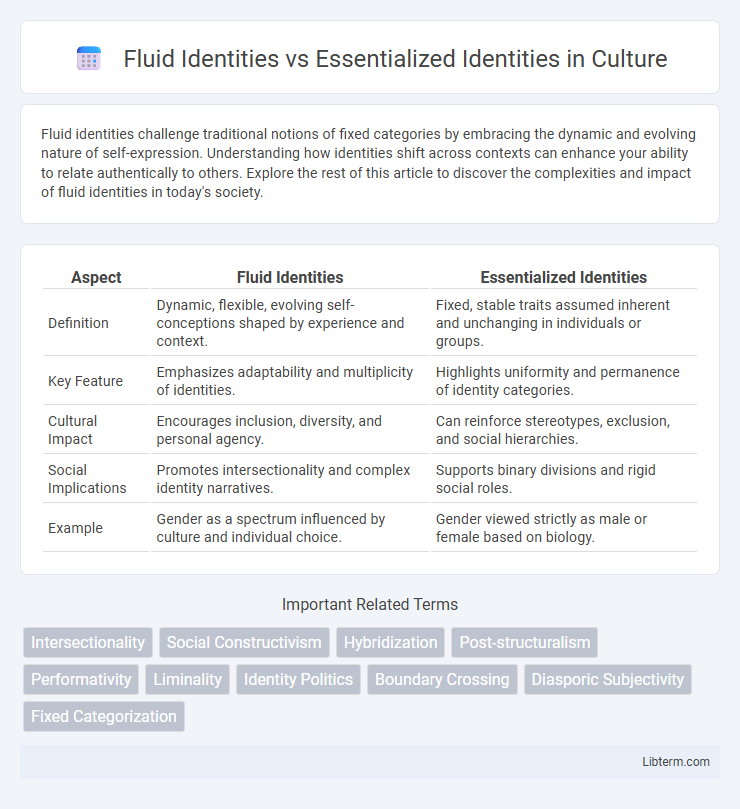Fluid identities challenge traditional notions of fixed categories by embracing the dynamic and evolving nature of self-expression. Understanding how identities shift across contexts can enhance your ability to relate authentically to others. Explore the rest of this article to discover the complexities and impact of fluid identities in today's society.
Table of Comparison
| Aspect | Fluid Identities | Essentialized Identities |
|---|---|---|
| Definition | Dynamic, flexible, evolving self-conceptions shaped by experience and context. | Fixed, stable traits assumed inherent and unchanging in individuals or groups. |
| Key Feature | Emphasizes adaptability and multiplicity of identities. | Highlights uniformity and permanence of identity categories. |
| Cultural Impact | Encourages inclusion, diversity, and personal agency. | Can reinforce stereotypes, exclusion, and social hierarchies. |
| Social Implications | Promotes intersectionality and complex identity narratives. | Supports binary divisions and rigid social roles. |
| Example | Gender as a spectrum influenced by culture and individual choice. | Gender viewed strictly as male or female based on biology. |
Understanding Fluid Identities: A Modern Perspective
Fluid identities reflect the dynamic and evolving nature of self-perception, allowing individuals to express multiple aspects of their identity based on context and experience. This modern perspective recognizes identity as a spectrum rather than a fixed state, challenging essentialized identities that categorize people into rigid, unchanging groups. Understanding fluid identities is crucial for fostering inclusivity and appreciating the complex interplay between personal agency and social influences.
Defining Essentialized Identities in Social Discourse
Essentialized identities in social discourse refer to fixed, inherent characteristics attributed to individuals or groups, often based on race, gender, ethnicity, or religion, which are assumed to be unchangeable and uniform. This perspective simplifies complex social identities into essential traits, leading to stereotyping and exclusionary practices that hinder recognition of individual diversity and intersectionality. The rigid categorization inherent in essentialized identities contrasts sharply with fluid identities, which acknowledge the dynamic, evolving nature of selfhood shaped by social, cultural, and personal experiences.
Historical Evolution of Identity Concepts
The historical evolution of identity concepts reveals a shift from essentialized identities, which view identity as fixed and innate based on race, gender, or ethnicity, to fluid identities that emphasize change, context, and personal agency. Early identity frameworks were grounded in rigid categories rooted in colonialism, nationalism, and scientific racism, reinforcing social hierarchies and exclusion. Contemporary theories embrace fluid identities to capture the dynamic, intersectional, and performative nature of selfhood in a globalized and digital age.
Cultural Influences on Identity Formation
Cultural influences play a crucial role in shaping fluid identities by allowing individuals to adapt and redefine themselves across diverse social contexts, reflecting evolving values and experiences. In contrast, essentialized identities emphasize fixed characteristics often rooted in longstanding cultural traditions and collective historical narratives. These differing approaches to identity highlight the dynamic interplay between personal agency and cultural heritage in identity formation.
The Role of Intersectionality in Fluid Identities
Intersectionality plays a crucial role in shaping fluid identities by acknowledging how overlapping social categories such as race, gender, class, and sexuality influence individual experiences and self-perceptions. Fluid identities resist essentialized identities' fixed and singular definitions, allowing for dynamic and context-dependent understandings of identity that reflect the complexity of lived experiences. This perspective enhances the analysis of power structures and social inequalities by emphasizing the interconnectedness of multiple identity dimensions.
Challenges of Essentialism in Contemporary Society
Essentialist identities impose rigid categorizations that often overlook individual complexity and intersecting social factors, leading to stereotyping and discrimination. This reductionist approach undermines personal autonomy and reinforces systemic inequalities in areas such as race, gender, and ethnicity. Contemporary society struggles with essentialism's failure to adapt to fluid, evolving identities that better reflect diverse lived experiences and social realities.
Media Representation: Fluid vs Essentialized Identities
Media representation of fluid identities emphasizes the dynamic and evolving nature of personal and social identities, reflecting diverse experiences and resisting fixed categorizations. Essentialized identities portray individuals through rigid, stereotypical traits linked to race, gender, or culture, often reinforcing limiting and oversimplified narratives. This distinction influences public perception by either promoting inclusivity and complexity or perpetuating exclusion and bias within societal discourse.
Impacts on Self-Expression and Belonging
Fluid identities enable individuals to explore and express diverse facets of themselves, fostering a dynamic sense of self that adapts to different social contexts. Essentialized identities, by contrast, impose fixed labels that can restrict personal expression and limit the sense of belonging to narrowly defined groups. This tension influences psychological well-being, social inclusion, and the ability to navigate complex cultural landscapes.
Navigating Identity in a Globalized World
Navigating identity in a globalized world involves understanding Fluid Identities, which embrace change and multiple affiliations shaped by diverse cultural, social, and digital influences, contrasting with Essentialized Identities that emphasize fixed, inherent traits tied to ethnicity, nationality, or tradition. Fluid identities allow individuals to adapt and integrate various aspects of selfhood in response to global interconnectedness and multicultural exchanges. This dynamic approach fosters inclusivity and personal growth, resisting rigid categorizations that essentialized perspectives often impose.
Toward Inclusive Narratives: Embracing Identity Fluidity
Fluid identities emphasize the dynamic and evolving nature of self-conception, challenging the rigid boundaries of essentialized identities that fix individuals into static categories. Embracing identity fluidity fosters inclusive narratives by validating diverse experiences and intersections, promoting empathy and social cohesion. This approach counters exclusionary frameworks, enabling recognition of multiplicity within personal and collective identities across cultural, gender, and ethnic spectrums.
Fluid Identities Infographic

 libterm.com
libterm.com